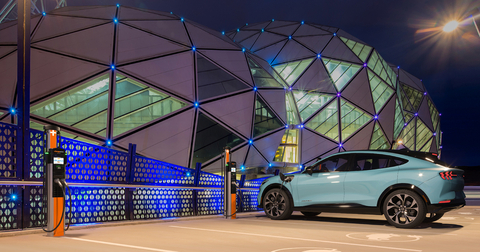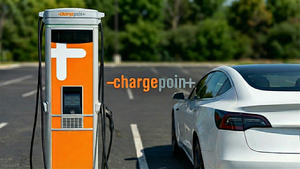ChargePoint (NYSE: CHPT), a leading provider of networked charging solutions for electric vehicles (EVs), announced today the trends it believes will propel EV charging growth. ChargePoint is working across all market segments and all classifications of electric vehicles to remain the leader in charging innovation, developing products now for this future ecosystem.
This press release features multimedia. View the full release here: https://www.businesswire.com/news/home/20240925867049/en/

ChargePoint is working across all market segments and all classifications of electric vehicles to remain the leader in charging innovation, developing products now for the future charging ecosystem. (Photo: Business Wire)
“The charging industry routinely discusses the ‘now,’ without saying much about the future,” said Rick Wilmer, CEO of ChargePoint. “ChargePoint remains focused on the opportunities ahead of us. Innovations that previously seemed futuristic are about to materialize, so we are excited to relay the trends and technologies that we believe will disrupt EV charging as we know it.”
Charging developments are soon coming to market via next generation products and features. The biggest technological leaps lie within the innovative software behind charging, which in turn will revolutionize the hardware it manages. Conversely, the chargers and the vehicles themselves are developing for V2X (vehicle to everything) capabilities. We expect these advancements will reshape the economics of home, fleet and municipal charging – often while balancing the electrical grid. Automotive manufacturers have realized they must fully embrace charging to sell more vehicles and deliver their desired customer experience. EVs are now a normal sight, and the new generation of vehicles is arriving with standard features that overcome barriers to EV adoption, such as an EPA-estimated range of more than 300 miles, and 800-volt platform architecture to enable faster charging.
For EV drivers, there are a variety of conveniences in the making. Most importantly, chargers that “just work” are here. The days of dealing with interoperability issues, aborted charging attempts, and other common frustrations are fading, paving the way for a smoother EV experience. Car manufacturers and the charging industry have collaborated to eliminate these growing pains from their next generation vehicles and chargers. “Plug and Charge” is finally rolling out: the concept of driving up to a charger, plugging it in, charging, and driving away upon completion. No authentication steps, no extra devices to start a charge, and automated payments in the background. ChargePoint is leading the industry by developing compatibility software and hardware. These products, which are rolling out now, enable seamless functionality between cars and major charging networks that were previously not open to one another, or did not have the right connector type for one another.
Software has become the key component in any EV charging solution, capable of unlocking the greatest benefits. Examples include real-time charger visibility for networks, the deployment of AI to facilitate charger reliability, and power sharing to maximize charging efficiency. This highlights the immense value software brings to the table, beyond just networking chargers. Much like “software defined vehicles,” the ecosystem which fuels them is rapidly becoming one of “software defined charging,” where success is reached in the cloud – not on the ground.
In the realm of hardware, visions are finally becoming a reality. The cost of a charger is gradually declining, while we expect features and benefits which enable a connected, electrified society will soon be rolling out. For vehicle charging at home, AC will remain the norm, but offer more functionality. When vehicle to home charging (V2H) is desired, a switch to DC current will be the answer. DC will better enable V2H capabilities, such as solar integration and using your car as a backup home electricity solution. Advancements in AC charging technology have approached its limits, so for public and commercial charging the future will focus on affordability, prompting more installations. We expect DC fast charger offerings to standardize around three speed ranges, based on the types of businesses which offer charging, and typical grid power available at their facilities. For example, a convenience store might offer charging at 50 kW, a grocery store can offer 200 kW, and a dedicated travel center can accommodate 400 kW fast charging. Charging providers will benefit from more affordable DC charging solutions, which will combine with vehicle to grid (V2X) capabilities to serve as a critical grid resource.
For auto manufacturers, the charging experience is no longer an afterthought, and they have invested heavily in second generation vehicles. These vehicles address previous barriers to entry while offering the features EV drivers aspire to have. Still in its infancy, we believe bidirectional energy capabilities will quickly become the norm. Advances in EV battery technology will bring down cost and weight, while increasing the charging speeds these batteries are capable of. We expect that charging speeds will cap at 600-700 kW for vehicles on 800V architectures, as there is no practical use case for charging faster.
In conclusion, charging companies and EV manufacturers have been working hard to address the challenges associated with first generation technology, and many of those improvements are available now. Next, the industry can move from a focus on core functionalities to affordability, reliability and aspirational features. ChargePoint is at the forefront of this evolution and will release new products and features to drive the future of charging in real time.
ChargePoint and the ChargePoint logo are trademarks of ChargePoint, Inc. in the United States and in jurisdictions throughout the world. All other trademarks, trade names, or service marks used or mentioned herein belong to their respective owners.
About ChargePoint Holdings, Inc.
ChargePoint has been an innovator of all things EV charging since 2007, before the first mass market electric vehicle was on the road. ChargePoint offers solutions for the entire EV ecosystem including drivers, charging station owners, vehicle manufacturers and others. Accessible and reliable, ChargePoint’s portfolio of software, hardware, and services enables a seamless experience for drivers across North America and Europe. With ChargePoint, every driver who needs to charge can do so, accessing more than 1 million places to charge globally. ChargePoint has powered more than 10 billion electric miles and will continue to innovate as part of a mission to lower global emissions while improving the future of transportation. For more information, visit the ChargePoint pressroom, the ChargePoint Investor Relations site, or contact the ChargePoint North American or European press offices or Investor Relations.
CHPT-IR
View source version on businesswire.com: https://www.businesswire.com/news/home/20240925867049/en/
Contacts
ChargePoint
John Paolo Canton
Vice President, Communications
JP.Canton@chargepoint.com
AJ Gosselin
Director, Corporate Communications
AJ.Gosselin@chargepoint.com
media@chargepoint.com







